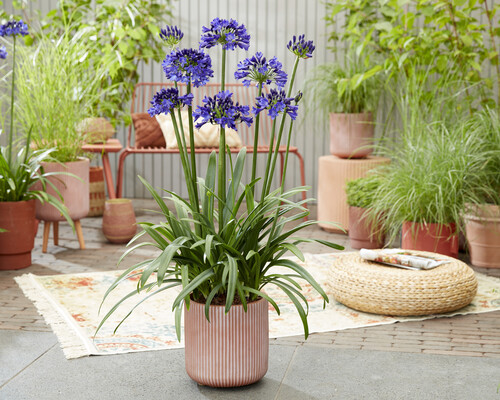The Ultimate Agapanthus Manual: Whatever You Required to Understand About Growing, Maintaining, and Delighting In These Lovely Flowers
Within the world of horticulture, couple of blossoms emanate the elegance and beauty rather like agapanthus. The Ultimate Agapanthus Handbook serves as a detailed overview to help you navigate the world of these stunning flowers, covering whatever from choosing the excellent range for your garden to grasping the art of upkeep and treatment.
:max_bytes(150000):strip_icc()/agapanthus-growing-guide-7368912_04-66a3f4cf245b4332b28954dd37c784f5.jpg)
Agapanthus Varieties: Picking the Right One
When selecting an Agapanthus range, it is essential to think about aspects such as blossom height, shade, and hardiness to ensure the ideal fit for your garden. The flower shade of Agapanthus ranges from shades of purple and blue to white and even bi-colored blossoms, providing a wide array of choices to complement your yard's color plan. Furthermore, elevation is an essential aspect to think about as Agapanthus ranges can vary from dwarf ranges that stay under a foot tall to bigger selections that can reach up to 4 feet in elevation.

Planting Tips for Healthy Development
To ensure successful development and growth of Agapanthus plants, appropriate growing techniques are crucial for establishing a healthy and balanced structure. Begin by selecting an ideal place that receives full sun to partial shade, as Agapanthus grows in these problems. The soil should be well-draining to stop waterlogging, which can lead to root rot. Before growing, modify the dirt with raw material like compost to improve its fertility and structure.
When planting Agapanthus, see to it the crown-- where the roots meet the stems-- goes to soil degree. Spacing in between plants need to be regarding 12-24 inches to enable ample air flow and future growth. Water recently planted Agapanthus deeply to help the roots develop themselves. Mulching around the plants can aid preserve wetness and subdue weeds.
Routine watering is crucial, specifically during the growing season, to promote healthy flowering. Feed Agapanthus in the springtime with a well balanced fertilizer to support robust growth and lively flowers. By adhering to these growing tips, you can delight in lovely and prospering Agapanthus plants in your garden.
Necessary Treatment and Upkeep Practices
Having actually established a solid structure through proper growing methods, the next critical action for making sure the health and vitality of Agapanthus plants exists in applying necessary care and maintenance methods. Agapanthus plants profit from a well balanced fertilizer application in the spring to sustain healthy growth and lively blossoms.
Deadheading invested flowers advertises continuous blooming and stops the plant from using up energy on seed manufacturing. In addition, splitting jampacked globs every couple of years renews the plants, promotes better blooming, and protects against my sources congestion. Agapanthus plants are usually low-maintenance yet may gain from regular evaluation for conditions and parasites. Slugs and snails can be controlled via manual elimination or eco-friendly insect control methods. By complying with these necessary care and upkeep techniques, garden enthusiasts can take pleasure in the charm of Agapanthus plants every year (Agapanthus).
Taking Full Advantage Of Flowers: Feeding and Watering
Applying a strategic feeding and watering program is necessary for taking full advantage of the flowering potential of Agapanthus plants throughout the growing period. Agapanthus plants require a balanced method to feeding and watering to thrive and generate an abundance of gorgeous flowers. When see page it pertains to feeding, making use of a balanced plant food with a greater potassium web content can promote flower production. It is advised to apply a slow-release fertilizer at the start of the growing period and afterwards supplement with a fluid plant food every 4-6 weeks throughout the active development period.
In regards to watering, Agapanthus plants prefer continually moist however well-drained dirt. Water deeply and rarely to urge deep origin growth and stop waterlogging, which can result in root rot. During the warm summer season months, boost watering regularity to guarantee the plants receive an ample amount of moisture. Mulching around the plants can help maintain soil moisture and control soil temperature level. By complying with a regular feeding and sprinkling regular, you can guarantee that your Agapanthus plants flourish and generate an excellent display screen of blossoms.
Imaginative Ways to Appreciate Agapanthus Flowers
Cut Agapanthus blossoms can be set up in a vase on their combined or very own with other complementary blossoms to add a touch of style to any area. Planting Agapanthus in clusters along borders or pathways can create a striking visual impact in your yard. In addition, you can use Agapanthus flowers to add a pop of shade to your patio or terrace by placing potted plants tactically to brighten up your exterior living rooms.

Conclusion
In verdict, agapanthus blossoms are a beautiful addition to any kind of garden, with a range of species to choose from. Obtain innovative with how you enjoy agapanthus, whether in arrangements, setups, or as a focal point in your yard.

Agapanthus plants benefit from a well balanced fertilizer application in the springtime to support healthy and balanced development and vibrant blossoms.
Implementing a strategic feeding and watering regimen is necessary for optimizing the blooming capacity of Agapanthus plants throughout the growing period. Agapanthus plants call for a well balanced method to feeding and watering to imp source produce an abundance and grow of attractive blossoms. Additionally, you can use Agapanthus blossoms to include a pop of shade to your patio area or balcony by placing potted plants purposefully to brighten up your outdoor living spaces.
Comments on “Seasonal Agapanthus Care: Getting Ready For Winter Season and Summer”